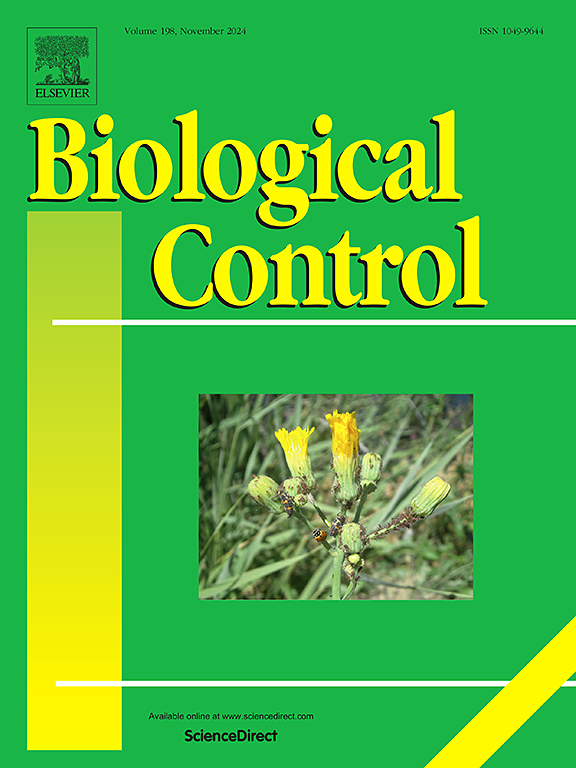Unveiling the parasitoid Euplectrus carinifer for controlling Chrysodeixis chalcites larvae in greenhouse environments
IF 3.4
2区 农林科学
Q2 BIOTECHNOLOGY & APPLIED MICROBIOLOGY
引用次数: 0
Abstract
The golden twin-spot moth or tomato looper, Chrysodeixis chalcites (Lepidoptera: Noctuidae), is a global pest, causing extensive damage to various crops and ornamental plants, leading to substantial economic losses. In 2018, an unidentified parasitic wasp was found in several greenhouses, where minimal damage from C. chalcites larvae was reported. This prompted an investigation to identify and characterize the species and analyze its life-history parameters.
Using an integrative morpho-bio-molecular approach, the parasitic wasp was identified as Euplectrus carinifer (Hymenoptera: Eulophidae). The study revealed that E. carinifer is a gregarious ectoparasitoid capable of parasitizing third to fifth (L3-L5) larval instars of C. chalcites, meanwhile no parasitism was observed on the first and second (L1-L2) larval instars. In a no-choice test, parasitism rates of E. carinifer were 45 % for L3, 75 % for L4 and 40 % for L5. Developmental time from egg to adult E. carinifer was 19.1 ± 0.2 days for L3, 20.0 ± 0.1 days for L4, and 21.5 ± 0.2 days for L5, at 22 °C. The average number of wasps emerging as adults was 3.7 ± 0.4 on L3, 7.7 ± 0.9 on L4, and 17.5 ± 1.6 on L5. In a choice test (L1-L5), female wasps showed a preference for L5 larvae (53.3 %), followed by L4 (26.7 %), and L3 (20.0 %).
Currently, no effective commercially available biological control agents exists in The Netherlands for managing C. chalcites. These findings suggest that E. carinifer holds substantial promise as a biological control agent for C. chalcites larvae in greenhouse environments.
揭示温室环境中拟寄生蜂对黄玉蛾幼虫的控制作用
金色双斑蛾或番茄环虫,黄斑蛾(鳞翅目:夜蛾科)是一种全球性害虫,对各种作物和观赏植物造成广泛危害,造成重大经济损失。2018年,在几个温室中发现了一种身份不明的寄生蜂,据报道,这些温室受到的危害最小。这促使了一项调查,以确定和表征该物种,并分析其生活史参数。利用形态-生物-分子综合方法,鉴定该寄生蜂为斑蜂(Euplectrus cariniifer)(膜翅目:蜂科)。研究结果表明,石纹姬螨是一种群居寄生蜂,能寄生于三~五龄(l3 ~ l5)黄纹姬螨幼虫,而寄生于一龄和二龄(l1 ~ l2)黄纹姬螨幼虫未见寄生。在无选择试验中,L3、L4和L5的寄生率分别为45%、75%和40%。在22℃条件下,从卵到成虫的发育时间L3为19.1±0.2 d, L4为20.0±0.1 d, L5为21.5±0.2 d。L3、L4、L5分别为3.7±0.4只、7.7±0.9只和17.5±1.6只。在选择试验(l1 ~ L5)中,雌蜂对L5幼虫的偏好为53.3%,其次是L4(26.7%)和L3(20.0%)。目前,荷兰还没有有效的商用生物防治剂来管理chalcite。这些研究结果表明,在温室环境中,肉毒莲作为一种生物防治剂具有很大的前景。
本文章由计算机程序翻译,如有差异,请以英文原文为准。
求助全文
约1分钟内获得全文
求助全文
来源期刊

Biological Control
生物-昆虫学
CiteScore
7.40
自引率
7.10%
发文量
220
审稿时长
63 days
期刊介绍:
Biological control is an environmentally sound and effective means of reducing or mitigating pests and pest effects through the use of natural enemies. The aim of Biological Control is to promote this science and technology through publication of original research articles and reviews of research and theory. The journal devotes a section to reports on biotechnologies dealing with the elucidation and use of genes or gene products for the enhancement of biological control agents.
The journal encompasses biological control of viral, microbial, nematode, insect, mite, weed, and vertebrate pests in agriculture, aquatic, forest, natural resource, stored product, and urban environments. Biological control of arthropod pests of human and domestic animals is also included. Ecological, molecular, and biotechnological approaches to the understanding of biological control are welcome.
 求助内容:
求助内容: 应助结果提醒方式:
应助结果提醒方式:


